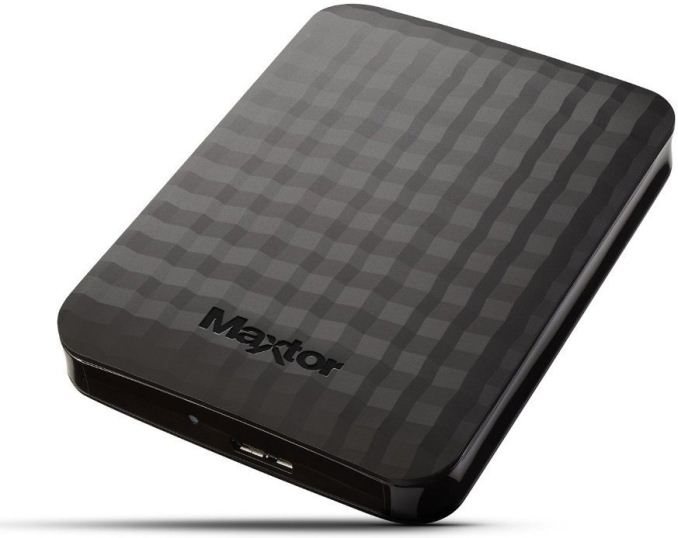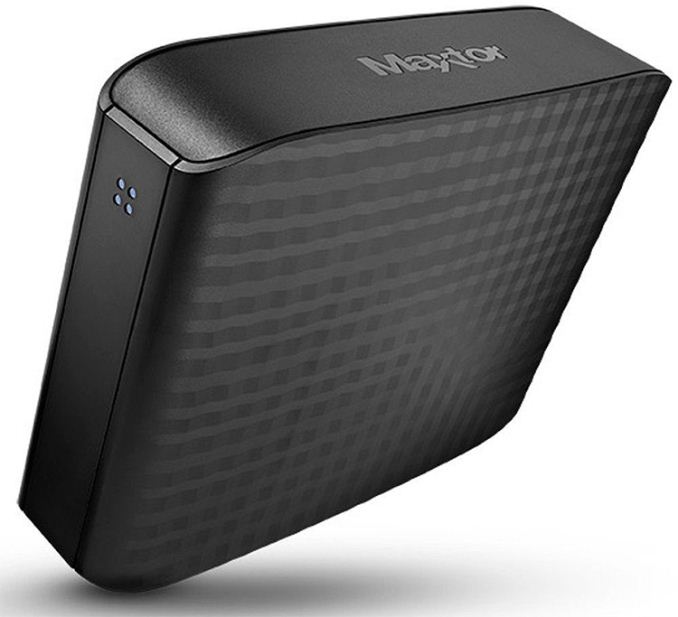Seagate Revives Maxtor Brand for External Storage
by Anton Shilov on December 1, 2016 8:00 AM EST
UPDATE 12/1 9AM: Seagate confirmed Thursday that it decided to revive the Maxtor brand in a bid to sell value products. In the coming months the company plans to phase-out its inexpensive Samsung-branded products and Maxtor will take their place.
Seagate has quietly started to sell Maxtor-branded external storage devices in various countries. At present, the company offers the Maxtor M3 and the Maxtor D3 Station DAS devices, which it also sells under the Samsung name (yes, you read that right - click here for proof). Right now, it is unclear for how long Seagate plans to use the trademark, which it has not touched for quite a while.
Maxtor was a major maker of hard drives that was founded in 1982 and acquired by Seagate in 2006. In the early 2000s, Maxtor was the largest maker of HDDs in the world after its acquisition of HDD division from Quantum, but its advantages somewhat diminished by the middle of the decade due to various reasons, such as the lack of a comprehensive lineup of 2.5” hard drives in the product stack. Maxtor faced severe financial troubles for the most part of its history, and after it was acquired it was also plagued by quality problems as well as controversial management decisions. After Seagate took the company over in 2006, it did ship Maxtor-branded internal and external drives for a couple of years (in fact, external storage was a strong side of Maxtor), but eventually the trademark was dropped.
Earlier this year Seagate decided to start using the Maxtor brand again to sell its M3 and D3 Station external storage products. Both of the DAS devices are also known as the Samsung M3 as well as the Samsung D3 Station which are available worldwide today. In fact, it is surprising to see that Seagate still uses the Samsung brand for hard drive products about five years after the acquisition of Samsung’s HDD business. Under the initial agreement, Seagate had rights to use the Samsung trademark for hard drives for 12 months following the buyout. Apparently, the two companies have amended the initial agreement as Seagate currently offers four Samsung-branded products for consumers. Meanwhile, the revival of the Maxtor brand could indicate that Seagate has begun to phase-out use of the Samsung trademark for its products, which is why it creates alternatives featuring a different brand (some may say that we are dealing with a plain re-badging).
| Seagate’s Maxtor DAS Lineup | ||||||
| Product | Capacity | Interface | Dimensions W×L×H (mm) |
Model Number | ||
| M3 | 500 GB | USB 3.0 | 82 × 112 × 17.5 | STSHX-M500TCBM | ||
| 1 TB | STSHX-M101TCBM | |||||
| 2 TB | STSHX-M201TCBM | |||||
| 3 TB | 82 × 118.2 × 19.85 | STSHX-M301TCBM | ||||
| 4 TB | STSHX-M401TCBM | |||||
| D3 Station | 2 TB | 129.2 × 180.6 × 129.2 | STSHX-D201TDBM | |||
| 3 TB | STSHX-D301TDBM | |||||
| 4 TB | STSHX-D401TDBM | |||||
| 5 TB | STSHX-D501TDBM | |||||
The Maxtor M3 external drive offers 500 GB, 1 TB, 2 TB and 4 TB capacities via a USB 3.0 interface. The top of the range Maxtor M3 model is based on the Spinpoint M10P 2.5”/15 mm HDD with five 800 GB platters featuring shingled magnetic recording technology at 5400 RPM spindle speed as well as 16 MB of cache. In the meantime, models with lower capacities use different hard drives and have smaller dimensions. The DAS comes with AutoBackup and SafetyKey software for automatic backup and protection.
The Maxtor D3 Station uses two 2.5” HDDs to offer 2 TB, 3 TB, 4 TB and 5 TB capacities (as opposed to up to 6 TB offered by the Samsung D3 Station version). Just like the M3, the DAS uses a USB 3.0 interface both for data transfer and for power. In addition it also comes with AutoBackup and SafetyKey. Since the D3 Station is designed to serve essential storage needs, it is basically a JBOD device that does not offer any kind of RAID for additional performance or reliability (it also makes for an inconsistent performance profile).
At present, Seagate uses its own brand to sell various external storage devices, the LaCie trademark for premium DAS products and the Samsung brand for select inexpensive external storage solutions. On Thursday the company said that it plans to continue using three brands for its external storage devices going forward with Maxtor taking the the place of Samsung. Seagate intends to add more products into the Maxtor lineup when it makes sense. The statement by Seagate reads as follows.
"Seagate’s consumer strategy is to have three brands to serve our customers varied external storage needs. Seagate (mainstream), LaCie (premium/creative pro) and Maxtor (value)," the company indicated. "The Samsung external HDD line is indeed being transitioned to the revived Maxtor brand. We will continue to provide products under the Maxtor brand and evolve the line as it makes sense."
At present, the Maxtor M3 and the Maxtor D3 Station products are available at Amazon and multiple other online and retail stores across the world.
Related Reading:
Source: Seagate












36 Comments
View All Comments
BurntMyBacon - Friday, December 2, 2016 - link
Samsung's Spinpoint F1 and F3 drives may not have been the fastest by the time all of their competition dropped their newest competitors, but they were definitely close. I'm pretty sure you are correct about the F1 being the fastest at launch. More impressively, they did it while remaining much cooler and quieter than the competition.Samus - Thursday, December 1, 2016 - link
Seagate has a history of acquiring shitbox companies. And so does Maxtor.Maxtor acquired Quantum, and both companies for the longest time made complete crap from the Quantum Bigfoot to the Quantum LCT (low cost technology) drives. Quantums magnetic tape division was their only bright spot and is presumably the only reason Maxtor bought them.
Maxtor basically had the worst failure rates in the industry for years leading up until their inevitable bankruptcy and purchase by Seagate. I don't know what Seagate saw in Maxtor, but it was perhaps the IP from Quantum's DAT technology.
But before all of this was the hilarious acquisition of Conner Peripherals. Conner perhaps made the most unreliable, and most ridiculous hard disk designs of all time. They actually made a dual actuator drive that effectively doubled the failure rate while not even increasing performance (the bus at the time was too limited to best the transfer rates of high rpm drives.) I'd never seen as many drives fail so systematically as Conner drives.
The irony is, though most of these acquisitions, from the mid 90's to the mid 00's, Seagate made what I would consider THE MOST RELIABLE hard drives. Remember this was a time of the WD BB models that were out classed by their own JB models in reliability and performance. And who could forget the Deathstar 75GXP with their chronic GMR head failures. Yes, the Seagate 7200.7 was infinitely more reliable, faster, and quieter, than every other competitor at the time, and after buying Maxtor they really went to shit. These days, you are almost crazy to consider Seagate over WD or what's left of Hitachi. I keep hearing Seagate newer products are better, but considering they just rebuilt their entire product portfolio (iron wolf, really?) I think even they know something needs to happen with their product image, because the barracuda model brings shivers to my spin. And I'm not the only one, appearantly.
PandaBear - Friday, December 2, 2016 - link
7200.7 is very reliable, I am still using two 120gb daily at 13 year, migrate on every upgrade.Flunk - Wednesday, December 7, 2016 - link
I still have 2 7200.7 drives that have been in my file server, powered constantly for about 10 years.BurntMyBacon - Friday, December 2, 2016 - link
But I like my Quantum Bigfoot. It is still just as functional today as the day I got it. Which is to say I acquired a broken drive and pulled the platters out for use as ornaments. Picks up fingerprints like mad though.Morawka - Thursday, December 1, 2016 - link
i have the opposite experience with seagate drives.. If you have so many that fail, perhaps your operating conditions are bad.Give the 3.5 drives plenty of airflow, and use rubber based mounting mechanisms to cut down on vibration. Also, when you get a new drive, don't immediately fill it up to 75% or more. the heads were not built for continuous writing for 24 hour. Instead, fill up 30% per day
ohnoausername - Thursday, December 1, 2016 - link
So you're literally going with "you're holding it wrong"? The plural of anecdote is not data, but I've seen scores of Seagate drives fail in the last few years, most of them from right after the Maxtor acquisition when we stopped using them. Seen one WD fail in that time. Seagate is junk.ohnoausername - Thursday, December 1, 2016 - link
And I should note that one WD was being used inappropriately.BurntMyBacon - Friday, December 2, 2016 - link
Were you holding it wrong?Morawka - Thursday, December 1, 2016 - link
well if i see erroneous data, i have to question what other variables are at play. it was purely a scientific observation.Hard drives are a commodity, and are usually built pretty much the same no matter who makes it.
Sure, there are different platter technologies, such as SMR, but my point is, they are built using the same components, same heads, same platters, same casing, etc..
WD just sells 20% of the drives that Seagate does, that's why you think seagate is bad.
Look at the latest backblaze report (Documentation of data center failures over time)
https://www.backblaze.com/blog/hard-drive-reliabil...